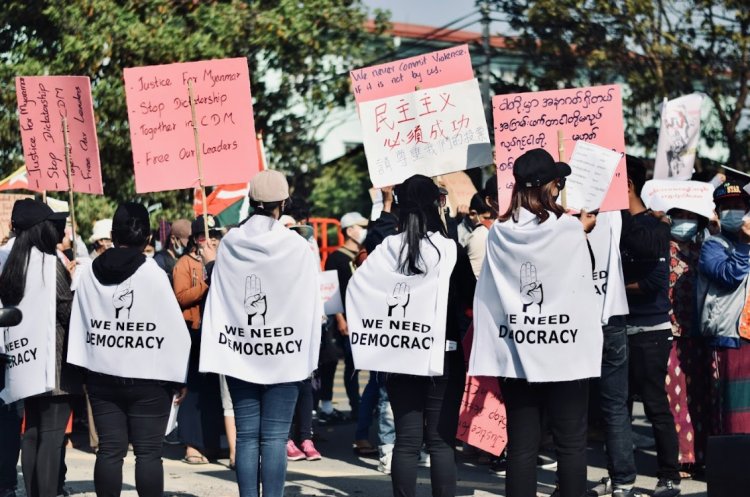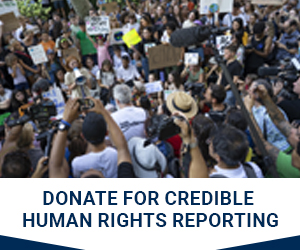The ongoing conflict in Myanmar: armed resistance groups are covering more ground and freeing civilians

04-04-2024
Pauliina Majasaari
Human Rights Researcher
Global Human Rights Defence
The ethnic armed forces from various states within Myanmar have been fighting in resistance to the Myanmar military’s, also known as the State Administration Council (SAC), violent conduct. With victorious takeovers of important areas, the resistance armed forces are seeing hope in freeing the people of Myanmar from the military junta’s oppressive power and retaining the much-wanted civilian government.
The Karenni National Defence Forces (KNDF), ethnic armed forces from Kayah State, entered the town of Shadaw in February 2024, and took control of the SAC’s outposts and their main camp.[i] In addition, the KNDF as well as the Karenni Army, which is the armed group connected to the Karenni National Progressive Party, have been trying for a period of a month to push out the SAC from two camps that have been set on the hill above the town of Shadaw.[ii] The KNDF and Karenni Army were successful in pushing the SAC away from the hill and consequently surrounded them in Shadaw, leading to a full combat, with mortars, machine guns, and aircrafts with bombs.[iii] The civilians of Shadaw town fled to a nearby valley, where the KNDF and the Karenni Army soldiers were trying to treat the wounded, and within a time span of two hours, the SAC launched 32 air strikes towards the hiding place of the civilians, leading to the deaths of at least six civilians and three injuries.[iv]
The SAC has been fighting against the armed resistance ethnic groups since the February 2021 military coup and the mass protests following it.[v] The Three Brotherhood alliance, consisting of three powerful ethnic armed forces, has been victorious in taking back power from the SAC in hundreds of military posts as well as dozens of villages.[vi] In addition to the conflict being centred mostly in the Rakhine and Shan states, the fighting has spread to Kayah State, which is right in the vicinity to the south of Shan State.[vii] The KNDF, conducted its own offensive starting on November 11th 2023, called ‘Operation 1111’, amongst which they were able to take back half of the capital, Loikaw, which was previously controlled by the Myanmar military as well as a strategically important township, Shadaw, within the Kayah State as mentioned before.[viii] Such takeovers by the armed resistance groups of towns is a major factor in gaining opportunities to ensure supplies are being transferred for the armies as well as allowing humanitarian aid to be present in towns that have been destroyed due to the warfare.[ix] The ethnic armed forces in Myanmar keep fighting and resisting the control of SAC, with the aim of gaining back the civilian government in Myanmar.[x]
The Fourth Geneva Convention, common article 3, prohibits certain acts that are targeted against civilians, who are not taking an active part in the hostilities.[xi] Such acts include, among others, violence to life and person and taking hostages.[xii] In addition, civilians not taking an active part in the hostilities must be treated humanely, which prohibits, among other things, arbitrary detention.[xiii] Furthermore, customary international humanitarian law states, under Rule 55, that parties to a conflict must allow access and facilitate fast and unimpeded passage to humanitarian relief for civilians in need.[xiv] The humanitarian organisations must receive consent from a state to deliver such aid, however, nations do not have the right to refuse consent on arbitrary grounds and in case the civilian population lacks supplies essential to its survival, consent should be granted.[xv] The SAC is acting in contradiction with international humanitarian law as the airstrikes conducted within the hiding place of the civilians after the invasion of the Shadaw town led to the deaths of six civilians not taking an active part in the hostilities, which is prohibited under common Article 3. Furthermore, the armed resistance forces have tried to free about 1,000 villagers held as hostages by the SAC in the Pasaung Township, which is in contradiction with the prohibition of taking hostages under common article 3. In addition, the villagers are arbitrarily detained as there is no legal basis for detaining the villagers since they do not pose an imperative threat to the security of the SAC.[xvi] Thereby the Myanmar military is not treating the civilians not taking an active part in the hostilities humanely as reiterated under common article 3. Additionally, there has been evidence of the SAC denying humanitarian aid, such as food, water, and adequate housing to be delivered to the displaced civilians.[xvii] Such actions are in contradiction with Rule 55, as food, water and shelter are essential for the survival of civilians and therefore Myanmar does not have the right to deny consent for humanitarian organisations to gain access and deliver the much needed aid to its territory.
Consequently, Myanmar is urged by the international community and humanitarian aid organisations to treat the villagers, who are civilians not taking an active part in the conflict, in a humane manner, as well as to stop killing the villagers, for being a party to the Geneva Conventions and thereby having obligations to follow the rules of international humanitarian law and protect villagers from warfare.[xviii] Furthermore, Myanmar is asked to allow humanitarian aid to be delivered to the millions of displaced individuals as they are facing shortages of food, water, and inadequate living conditions.[xix]
[i] Caleb Quinley, ‘’Fighting spirit’: How Myanmar’s resistance is taking new ground’ (Al Jazeera, 26 March 2024) <https://www.aljazeera.com/news/longform/2024/3/26/fighting-spirit-how-myanmars-armed-resistance-is-taking-new-ground> accessed 4 March 2024.
[i] ibid.
[ii] ibid.
[iii] ibid.
[iv] ibid.
[v] ibid.
[vi] Richard horsey, ‘A New Escalation of Armed conflict in Myanmar’ (International Crisis Group, 17 November 2023) <https://www.crisisgroup.org/asia/south-east-asia/myanmar/new-escalation-armed-conflict-myanmar> accessed 4 April 2024.
[vii] Caleb Quinley (n i).
[viii] ibid.
[ix] ibid.
[x] ibid.
[xi] Geneva Convention relative to the protection of civilian persons in time of war (adopted 12 august 1949, entered into force 21 October 1950) 75 UNTS 287 (Fourth Geneva Convention), Article 3.
[xii] ibid Article 3 (1) (a) and (b).
[xiii] Fourth Geneva Convention, Article 3 (1); ‘Rule 99.: Deprivation of Liberty: Arbitrary Deprivation of Liberty is Prohibited’ (ICRC) <https://ihl-databases.icrc.org/en/customary-ihl/v1/rule99> accessed 8 April 2024.
[xiv] Rule 55.: Access to Humanitarian Relief for Civilians in Need’ (ICRC) <https://ihl-databases.icrc.org/en/customary-ihl/v1/rule55> accessed 8 April 2024.
[xv] ibid.
[xvi] ibid 29.
[xvii] Barbara Woodward, ‘We must not allow Myanmar to become a forgotten crisis: UK statement at the UN Security Council (GOV.UK, 4 April 2024) <https://www.gov.uk/government/speeches/we-must-not-allow-myanmar-to-become-a-forgotten-crisis-uk-statement-at-the-un-security-council> accessed 8 April 2024.
[xviii] ‘Myanmar: Events of 2022’ (Human Rights Watch, 2023) <https://www.hrw.org/world-report/2023/country-chapters/myanmar> accessed 4 April 2024.
[xix] ‘Myanmar’s Human Rights Crisis: In Freefall with Insufficient International Attention’ (U.S. Committee for Refugees and Migrants, 29 February 2024) <https://refugees.org/myanmars-human-rights-crisis-in-freefall-with-insufficient-international-attention/> accessed 4 April 2024.




 GHRTV
GHRTV 




























